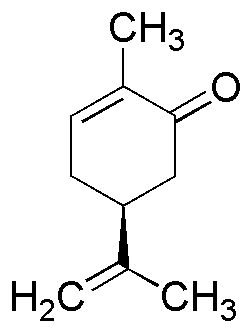D-Carvone is widely utilized in research focused on various applications across multiple industries.
- Flavoring Agent: Commonly used in the food industry, D-Carvone imparts a minty flavor to products like chewing gum, candies, and beverages, enhancing consumer appeal.
- Fragrance Component: In the cosmetic and personal care sectors, it serves as a key ingredient in perfumes and scented products, providing a refreshing aroma that is highly sought after.
- Aromatherapy: D-Carvone is utilized in essential oils for aromatherapy, promoting relaxation and well-being, making it popular among wellness practitioners.
- Pharmaceutical Applications: This compound is explored for its potential therapeutic properties, including antimicrobial and anti-inflammatory effects, which could lead to new medicinal formulations.
- Natural Insect Repellent: D-Carvone has been studied for its effectiveness as a natural insect repellent, offering an eco-friendly alternative to synthetic chemicals in pest control products.
General Information
Properties
Safety and Regulations
Applications
D-Carvone is widely utilized in research focused on various applications across multiple industries.
- Flavoring Agent: Commonly used in the food industry, D-Carvone imparts a minty flavor to products like chewing gum, candies, and beverages, enhancing consumer appeal.
- Fragrance Component: In the cosmetic and personal care sectors, it serves as a key ingredient in perfumes and scented products, providing a refreshing aroma that is highly sought after.
- Aromatherapy: D-Carvone is utilized in essential oils for aromatherapy, promoting relaxation and well-being, making it popular among wellness practitioners.
- Pharmaceutical Applications: This compound is explored for its potential therapeutic properties, including antimicrobial and anti-inflammatory effects, which could lead to new medicinal formulations.
- Natural Insect Repellent: D-Carvone has been studied for its effectiveness as a natural insect repellent, offering an eco-friendly alternative to synthetic chemicals in pest control products.
Documents
Safety Data Sheets (SDS)
The SDS provides comprehensive safety information on handling, storage, and disposal of the product.
Product Specification (PS)
The PS provides a comprehensive breakdown of the product’s properties, including chemical composition, physical state, purity, and storage requirements. It also details acceptable quality ranges and the product's intended applications.
Certificates of Analysis (COA)
Search for Certificates of Analysis (COA) by entering the products Lot Number. Lot and Batch Numbers can be found on a product’s label following the words ‘Lot’ or ‘Batch’.
*Catalog Number
*Lot Number
Certificates Of Origin (COO)
This COO confirms the country where the product was manufactured, and also details the materials and components used in it and whether it is derived from natural, synthetic, or other specific sources. This certificate may be required for customs, trade, and regulatory compliance.
*Catalog Number
*Lot Number
Safety Data Sheets (SDS)
The SDS provides comprehensive safety information on handling, storage, and disposal of the product.
DownloadProduct Specification (PS)
The PS provides a comprehensive breakdown of the product’s properties, including chemical composition, physical state, purity, and storage requirements. It also details acceptable quality ranges and the product's intended applications.
DownloadCertificates of Analysis (COA)
Search for Certificates of Analysis (COA) by entering the products Lot Number. Lot and Batch Numbers can be found on a product’s label following the words ‘Lot’ or ‘Batch’.
*Catalog Number
*Lot Number
Certificates Of Origin (COO)
This COO confirms the country where the product was manufactured, and also details the materials and components used in it and whether it is derived from natural, synthetic, or other specific sources. This certificate may be required for customs, trade, and regulatory compliance.


